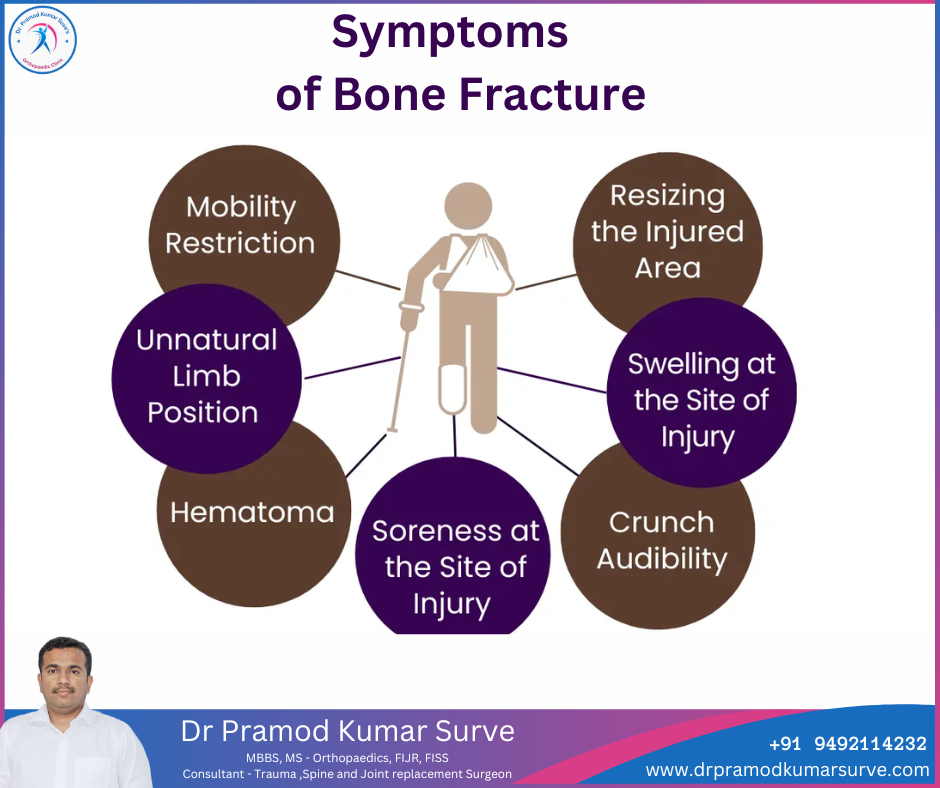What does fracture treatment mean?
Fractures are broken bones. There is not much difference between a fracture and a break. Both are used as two different terms for the same condition. Fracture treatment, or fracture care, is creating an environment in which the broken or fractured bone can heal itself in different ways, but certain fractures require treatment when the injury is severe.
Fracture treatment in Pune depends on the location and severity. We at Bharath Orthopaedics aim to treat most of the fractures with painless treatment or without surgery.
Symptoms and Signs of Fractures
there are 5 types of symptoms and signs of fracture
- Severe pain
- Swelling
- Redness
- Difficulty in using the limbs
- Deformity
Causes of Bone Fractures
Causes of bone fractures can include:
- Terrible incidents such as injuries caused by weapons, car accidents, and falls require fracture treatment in Pune.
- Certain medical conditions, such as osteoporosis and various types of cancer, can render bones more vulnerable to damage, making even minor injuries and falls potentially serious.
Types of Bone Fractures
There is a range of fracture types that include:
- Avulsion Fracture: If the ligament or tendon pulls part of the bone off,.
- Closed or Open Fractures: A closed fracture is when the injury breaks open the skin, and if the skin does open, it is an open or compound fracture.
- Comminuted Fracture: The bone gets shattered into several pieces.
- Complete Fractures: If the bone breaks, it completely separates into two.
- Compression (crush) Fracture: The bone gets shattered or crushed.
- Displaced Fractures: There would be a gap formed when the bone breaks, and it can be mostly fixed by getting the fracture treatment in Chennai.
- Greenstick Fracture: when the bone partly fractures, causing a bend, but it does not break completely. Children who have softer bones with more elasticity often undergo treatment for this type of fracture.
- Hairline Fracture: the fracture of the bone is partial, and it’s hard to detect using routine X-rays.
- Impacted Fracture: One fragment of a bone gets driven together or goes into another when the bone is fractured.
- Intraarticular Fracture: The break extends into the surface of the joint.
- Longitudinal Fracture: The break is along with the bone’s length.
- Oblique Fracture: The break is diagonal across the bone or to a bone’s long axis.
- Partial Fractures: The break or fracture doesn’t go all the way through the bone.
- Pathological Fracture: The bone gets weakened due to pathological conditions like an underlying disease or condition, which results in a fracture.
- Spiral Fracture: The fracture spirals or twists around the bone.
- Stress Fracture: The bone breaks through repeated stresses or it gets cracked in, and most of the time it gets tough on the image. It is more common among athletes or sportspersons who require fracture treatment in Chennai.
- Torus (Buckle) Fracture: It is painful when the bone gets deformed, but it does not crack. It occurs mostly among children.
- Transverse Fracture: The break has a straight break, or it is a straight line across the bone.
When do you require fracture treatment?
1. Anyone who breaks their bones from falls, car or automobile accidents, or sports injuries requires fracture treatment in Chennai.
2. Older people with weaker bones have a great risk of falling.
3. Adults or children with underlying illnesses or conditions.
4. Medical conditions called osteoporosis treatment also play a major role.
Diagnosis and Tests of Fracture Treatment
Diagnostic Tests
- Physical Examination: The first step in diagnosing a fracture is a physical examination. The doctor will examine the affected area for signs of swelling, bruising, tenderness, and deformity. They may also check the range of motion and strength of the affected limb.
- X-rays: X-rays are the most commonly used diagnostic tool for fractures. They can detect even small cracks or breaks in bones. X-rays are quick, painless, and non-invasive.
- MRI (Magnetic Resonance Imaging): An MRI is a diagnostic test that uses a magnetic field and radio waves to create detailed images of the body’s internal structures. An MRI taken during the fracture treatment in Chennai can provide more detailed information than X-rays, especially for complex fractures or soft tissue injuries.
- CT (Computed Tomography) Scan: A CT scan uses X-rays and computer technology to create detailed images of bones and soft tissues. CT scans are particularly useful in identifying complex fractures that may be difficult to diagnose with X-rays.
